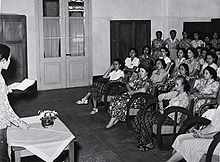| Born | 21 April 1879 |
|---|---|
| Died | 17 September 1904 (aged 25) Rembang, Central Java, Dutch East Indies (now Indonesia) |
| Other names | Raden Adjeng Kartini |
| Known for | Women's emancipation; national heroine |
| Spouse(s) | Raden Adipati Joyodiningrat |
| Children | Soesalit Djojoadhiningrat |
Kartini was the fifth child and second-eldest daughter in a family of eleven, including half-siblings. She was born into a family with a strong intellectual tradition. Her grandfather, Pangeran Ario Tjondronegoro IV, became a regency chief at the age of 25, while Kartini's older brother Sosrokartono was an accomplished linguist. Kartini's family allowed her to attend school until she was 12 years old. Here, among other subjects, she learned Dutch, an unusual accomplishment for Javanese women at the time.[4] After she turned 12 she was secluded (pingit) at home, which was a common practice among young female Javanese nobles, to prepare them for wedlock. During seclusion, girls were not allowed to leave their parents' house until they were married, after which the authority over them was transferred to their husbands. Kartini's father was more lenient than some during his daughter's seclusion, giving her such privileges as embroidery lessons and occasional appearances in public for special events.
During her seclusion, Kartini continued to self-educate herself. She was fluent in Dutch and acquired several Dutch pen friends. One of which, was a girl named Rosa Abendanon, who later became a close friend of her. Books, newspapers, and European magazines fed Kartini's interest in European feminist thinking and fostered the desire to improve the conditions of indigenous Indonesian women, which at the time had a very low social status.
Kartini's reading included the Semarang newspaper, to which she began to send contributions that were published. Before she was 20 she had read Max Havelaar and Love Letters by Multatuli. She also read De Stille Kracht (The Hidden Force) by Louis Couperus, the works of Frederik van Eeden, Augusta de Witt, the Romantic-Feminist author Cecile Goekoop-de Jong van Beek en Donk,[5] and an anti-war novel by Berta von Suttner, Die Waffen Nieder! (Lay Down Your Arms!). All were in Dutch.
Kartini was not only concerned with the emancipation of women but also other problems of her society. Kartini saw that the struggle for women to obtain their freedom, autonomy, and legal equality was just part of a wider movement.
Kartini's parents arranged her marriage to Joyodiningrat, the Regency Chief of Rembang, who had already married three wives. She was wed on 12 November 1903. She detested the marriage proposal at first, but her husband understood Kartini's aspirations and allowed her to establish a women's school on the eastern porch of Rembang's Regency Office complex. Kartini's only child was born on September 13, 1904. After which a few days later on 17 September 1904, Kartini died at the age of 25. She was buried at Bulu Village, Rembang.
Inspired by R.A. Kartini's example, the Van Deventer family established the R.A. Kartini Foundation which built schools for women, 'Kartini's Schools' in Semarang in 1912, followed by other women's schools in Surabaya, Yogyakarta, Malang, Madiun, Cirebon, and other areas.
In 1964, President Sukarno declared R.A. Kartini's birth date, 21 April, as "Kartini Day"—an Indonesian national holiday. This decision has been criticized. It has been proposed that Kartini Day should be celebrated in conjunction with Indonesian Mothers’ Day on 22 December. So R.A. Kartini as a national heroine does not overshadow women who took arms to oppose the Dutch.
In contrast, those who recognize the significance of R.A. Kartini argue that not only was she an intellectual who elevated the status of Indonesian women, she was also a nationalist figure with modern ideas, who struggled on behalf of her people and played a role in the national struggle for independence.



Komentar
Posting Komentar